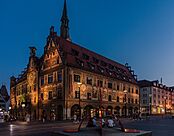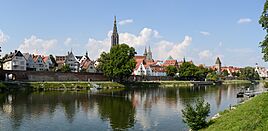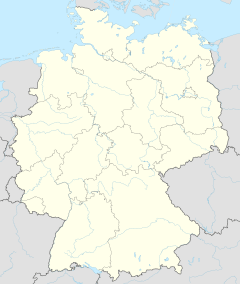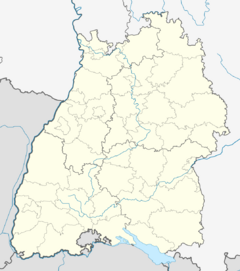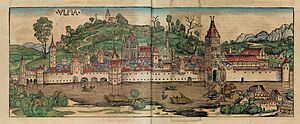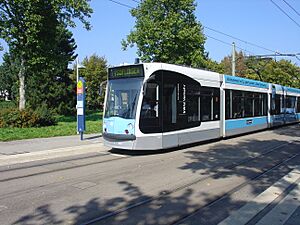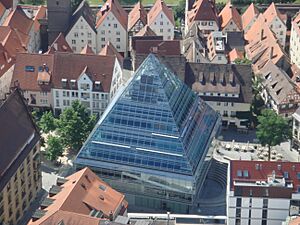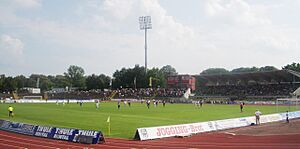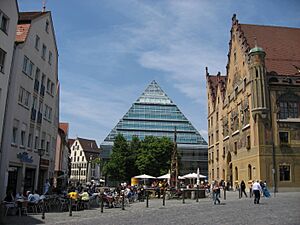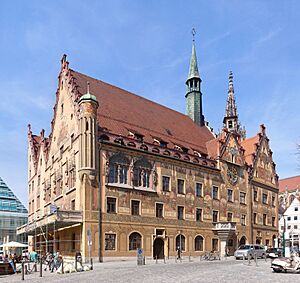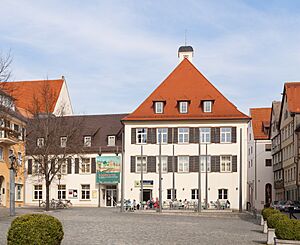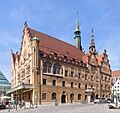Ulm facts for kids
Quick facts for kids
Ulm
|
|||
|---|---|---|---|
|
|
|||
|
|||
| Country | Germany | ||
| State | Baden-Württemberg | ||
| Admin. region | Tübingen | ||
| District | Urban district | ||
| First mentioned | 854 AD | ||
| Subdivisions | 18 Stadtteile | ||
| Area | |||
| • Total | 118.69 km2 (45.83 sq mi) | ||
| Elevation | 478 m (1,568 ft) | ||
| Population
(2022-12-31)
|
|||
| • Total | 128,928 | ||
| • Density | 1,086.26/km2 (2,813.40/sq mi) | ||
| Time zone | UTC+01:00 (CET) | ||
| • Summer (DST) | UTC+02:00 (CEST) | ||
| Postal codes |
89073–89081
|
||
| Dialling codes | 0731, 07304, 07305, 07346 |
||
| Vehicle registration | UL | ||
| Website | www.ulm.de | ||
Ulm is a city in southwestern Germany. It's the sixth-largest city in the state of Baden-Württemberg. About 129,000 people live here. This makes it Germany's 60th-largest city.
Ulm is located near the Swabian Jura mountains. It sits on the River Danube, where the small Blau Stream joins it. The Iller river also meets the Danube within Ulm's city limits. The Danube river forms the border with Bavaria. On the other side of the river is Neu-Ulm, Ulm's twin city. Ulm and Neu-Ulm used to be one city until 1810. Together, they have about 190,000 people. Ulm is an important city on the Danube River.
Ulm was founded around 850 AD. It has a rich history as a former "free imperial city." This means it was a special city that ruled itself. Today, Ulm is a center for business and industry. It is home to the University of Ulm and the Ulm University of Applied Sciences. The city is also on a major railway line connecting cities like Paris, Stuttgart, Munich, and Vienna. The Ulm Minster is a famous church here. It has the tallest church tower in the world!
In 1927, the small village of Wiblingen became part of Ulm. This brought Wiblingen Abbey into the city. The abbey has a beautiful library and a special relic. This relic is said to contain small pieces of the True Cross.
Many famous people were born in Ulm. These include Albert Einstein (a famous scientist) and Hildegard Knef (an actress and singer).
Contents
Exploring Ulm's Location
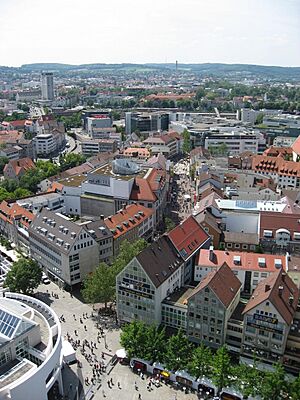
Ulm is where the Blau and Iller rivers flow into the Danube. It is about 479 meters (1,572 feet) above sea level. Most of the city, including the old town, is on the north side of the Danube. Only a few districts like Wiblingen are on the south side.
Across the river from the old town is Neu-Ulm. This twin city is in the state of Bavaria. Neu-Ulm is smaller than Ulm. It was part of Ulm until 1810.
Forests and hills surround Ulm. Some of these hills are part of the Swabian Alb mountains. They rise to over 620 meters (2,034 feet). South of the Danube, you can see the northern edge of the Alps on clear days. The Alps are about 100 kilometers (62 miles) away.
Ulm is in the northern part of the North Alpine Foreland basin. This is where the basin meets the Swabian Alb. There is a famous fossil site called the "Erminger Turritellenplatte" nearby.
Neighbors and City Parts
On the southeast side of the Danube and Iller rivers is Neu-Ulm. On the northwest side, Ulm is mostly surrounded by the Alb-Danube district.
Ulm has 18 different districts. These include Ulm-Mitte, Böfingen, and Wiblingen. Nine of these districts joined Ulm during a city reform in the 1970s. These districts have their own local councils. These councils advise the main city council on local issues. However, the main city council makes the final decisions for all of Ulm.
Ulm's Journey Through Time
People first settled in the Ulm area around 5000 BC. This was during the early Stone Age. The oldest written record of Ulm is from July 22, 854 AD. King Louis the German signed a document in a royal palace called "Hulma."
Ulm became important because it was a "Königspfalz." This was a place where medieval German kings and emperors could stay. Later, Ulm grew into a city of traders and craftspeople. In 1397, a key document called the "Großer Schwörbrief" was signed. This agreement between rich families and trade groups was like an early city constitution. It showed how strong Ulm's citizens were.
The building of the huge Ulm Minster church began in 1377. The people of Ulm paid for it themselves. This also showed their independence. Ulm was very successful in the 1400s and 1500s. This was thanks to its high-quality textiles. The city was on important trade routes to Italy. This time was also a golden age for art in Ulm. Famous painters and sculptors like Hans Multscher worked here.
Ulm became Protestant in 1530 during the Reformation. The city slowly declined after new trade routes opened up. The Thirty Years' War (1618–1648) also caused problems. During the War of the Spanish Succession (1701–1714), French and Bavarian soldiers took over the city several times.
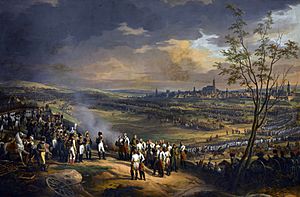
After the French Revolution, French and Austrian armies often occupied Ulm. In 1803, Ulm lost its special "Imperial City" status. It became part of Bavaria. In 1805, Napoleon's army defeated the Austrian army in the Battle of Ulm. In 1810, Ulm joined the Kingdom of Württemberg. Its districts on the other side of the Danube became Neu-Ulm.
In the mid-1800s, Ulm became a fortress. Large military buildings were constructed to protect against French attacks. Ulm also became an important industrial center in southern Germany. The construction of the Minster, which had stopped, was finished between 1844 and 1891.
From 1933 to 1935, a concentration camp was built on the Kuhberg hill. It was mainly for people who opposed the Nazi government. The Jewish people in Ulm faced discrimination. Their synagogue was destroyed in November 1938 during a terrible event. Many Jewish people from Ulm were later sent away during World War II. Only a few returned.
During World War II, Ulm was bombed on December 17, 1944. Factories, barracks, and hospitals were hit. Many parts of the old city center were destroyed. Over 80% of it was in ruins.
After the war, some parts of Ulm were rebuilt in a simple style. But most of the historic old town was restored. Ulm grew a lot after World War II. New homes and industrial areas were built. In 1967, Ulm University was founded. This was very important for the city's growth. Since the 1980s, Ulm has moved from old industries to high-tech. Companies like Daimler, Siemens, and Nokia have research centers here. Ulm continues to grow today. It is a twin city with Neu-Ulm, and it benefits from being between Stuttgart and Munich.
People of Ulm
| Historical population | ||
|---|---|---|
| Year | Pop. | ±% |
| 1300 | 4,000 | — |
| 1400 | 9,000 | +125.0% |
| 1550 | 19,000 | +111.1% |
| 1750 | 15,000 | −21.1% |
| 1818 | 13,000 | −13.3% |
| 1871 | 26,290 | +102.2% |
| 1900 | 42,982 | +63.5% |
| 1910 | 56,109 | +30.5% |
| 1919 | 56,020 | −0.2% |
| 1925 | 57,278 | +2.2% |
| 1933 | 62,472 | +9.1% |
| 1939 | 75,503 | +20.9% |
| 1946 | 58,087 | −23.1% |
| 1950 | 71,132 | +22.5% |
| 1956 | 90,530 | +27.3% |
| 1961 | 92,705 | +2.4% |
| 1970 | 92,943 | +0.3% |
| 1987 | 103,494 | +11.4% |
| 2011 | 117,541 | +13.6% |
| 2017 | 125,596 | +6.9% |
| 2018 | 125,805 | +0.2% |
| 2019 | 126,329 | +0.4% |
| Population size may be affected by changes in administrative divisions. source: | ||
Ulm is a diverse city. Many people from different countries live here. Some of the largest groups are from Turkey, Italy, and Croatia.
Ulm's Economy
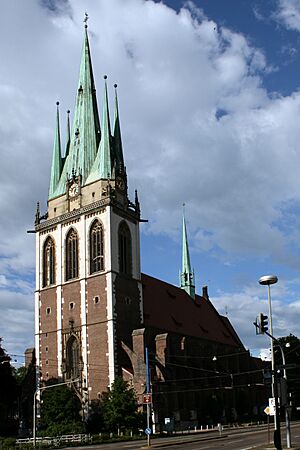
Ulm has a long history of trade and industry. A railway station was built in 1850, helping it grow. Important industries include machinery, electronics, and medicine.
The University of Ulm was founded in 1967. It focuses on science, medicine, and engineering. This helped Ulm move towards high-tech industries. This was especially important after older industries faced challenges in the 1980s.
Many companies have their main offices or important sites in Ulm.
- Gardena makes gardening tools.
- Iveco Magirus makes vehicles.
- Liqui Moly makes oils and car care products.
- Müller is a big German trading company.
- Ratiopharm makes medicines.
- Walther Arms makes firearms.
- Companies like Daimler, Siemens, and Nokia Networks have research centers here.
Green Efforts in Ulm
In 2007, Ulm won an award for its energy management. The city works hard to fight climate change.
- There's a power plant that uses biomass (plant material) for energy.
- The "Energon" building is the world's largest passive house office building. It uses very little energy.
- Ulm is one of the top cities in Germany for solar power production.
- New buildings must meet strict energy standards.
- The Ulm Minster has used only renewable energy since 2008.
- There's even a solar-powered ferry that crosses the Danube in summer!
- A group called "Bündnis 100% Erneuerbare Energien" aims for Ulm and Neu-Ulm to use 100% renewable energy by 2030.
Getting Around Ulm
Ulm is located where two major highways meet. The A8 motorway connects Stuttgart and Munich. The A7 motorway runs from northern to southern Europe.
The city's main train station, Ulm Hauptbahnhof, is on a big European train route. You can travel from Paris to Budapest through Ulm. Direct trains to Berlin are also available.
Ulm's public transport includes many bus lines and two tram lines. Some streets in the old town are only for people walking or cycling.
Learning and Culture in Ulm
The University of Ulm was founded in 1967. It focuses on science, medicine, and engineering. It has about 10,000 students.
Ulm also has a University of Applied Sciences. It started in 1960 as an engineering school. It welcomes students from all over the world.
The Ulm School of Design was founded in 1953. It was an important design school, similar to the Bauhaus school. It closed in 1968.
Ulm's public library has over 480,000 books and other media. The city has a public theater with plays, operas, and ballets. There is also a professional orchestra.
Sports in Ulm
Ulm is home to two main sports clubs:
- SSV Ulm 1846: This is a multi-sports club. Its football team plays in the second highest German league.
- Ratiopharm Ulm: This is a basketball club. They play in Germany's top basketball league.
Amazing Sights in Ulm
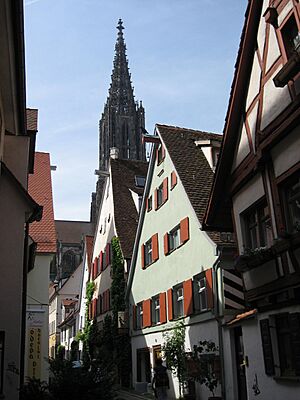
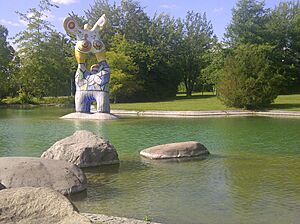
Historic Places to See
- Ulm Minster: This church was built from 1377 to 1891. It has the world's tallest church tower, at 161.53 meters (530 feet) high. You can climb 768 steps to the top! Inside, see beautiful wood carvings by Jörg Syrlin the Elder.
- The old Fischerviertel (fishermen's quarter): This area is along the River Blau. It has old half-timbered houses, cobblestone streets, and pretty bridges. Look for the Schiefes Haus Ulm (crooked house). It's a 16th-century house that is now a hotel.
- City Walls: You can still see parts of the old city walls along the river. The 14th-century Metzgerturm (butchers' tower) is 36 meters (118 feet) tall.
- The Rathaus (Town Hall): Built in 1370, it has colorful paintings from the 1500s. There's also an astronomical clock from 1520. It was rebuilt after being damaged in 1944.
- The Krone inn: This was a medieval hotel where German kings and emperors stayed.
- Ulm Federal Fortifications: These are large old forts built from 1842 to 1859. They were made to protect the city.
- Wiblingen Abbey: This former monastery is in the Wiblingen suburb. Its church is beautiful, and its library is a masterpiece of rococo style.
Modern Buildings to Admire
- Building of the Ulm School of Design: An important design school from 1953 to 1968.
- Stadthaus: A modern building for public events, right next to the Minster.
- Stadtbibliothek: Ulm's public library building. It's a glass pyramid designed by Gottfried Böhm, next to the town hall.
- Kunsthalle Weishaupt: A modern art gallery in Ulm's New Centre.
Museums to Explore
- The Kunsthalle Weishaupt: This museum has a private collection of modern art from 1945 onwards.
- Museum Ulm: Here you can see art from the Middle Ages. It also has the Löwenmensch figurine. This 40,000-year-old sculpture of a lion-man is the oldest known human-animal sculpture in the world!
- The Museum of Bread Culture: This museum shows the history of grain, baking, and bread.
- The Donauschwäbisches Zentralmuseum: Learn about the history of the Danube Swabians, who were emigrants from this region.
Important Memorials
- Albert Einstein Memorial: A small memorial where Albert Einstein was born. His house was destroyed in 1944.
- Memorial to Hans and Sophie Scholl: This memorial on Münsterplatz remembers these two members of the Weiße Rose (White Rose). They were a resistance group against the Nazi regime. They grew up in Ulm.
- The Memorial to Deserters: Near the university's botanical garden. It honors those who left the German army during World War II. It shows that "Desertion is not wrong, war is."
Other Interesting Places
- The Botanischer Garten der Universität Ulm: The university's botanical garden.
- Tiergarten Ulm: The city's zoo.
Famous People from Ulm
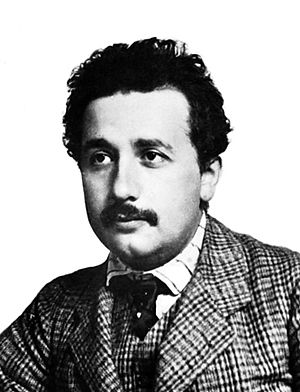
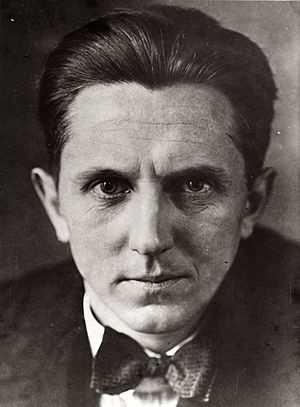
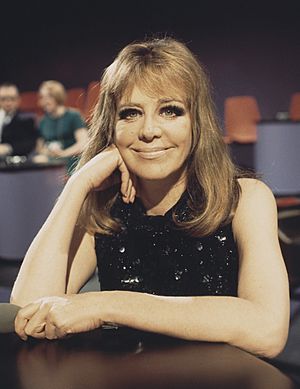
- Jörg Syrlin the Elder (c.1425–1491): A sculptor who made carvings for the Ulm Minster.
- Albert Einstein (1879–1955): A world-famous physicist and scientist. He won the Nobel Prize in Physics in 1921.
- Erwin Piscator (1893–1966): A famous theater director.
- Hildegard Knef (1925–2002): A well-known actress, singer, and writer.
- Otl Aicher (1922–1991): A graphic designer and co-founder of the Ulm School of Design.
Sports Stars from Ulm
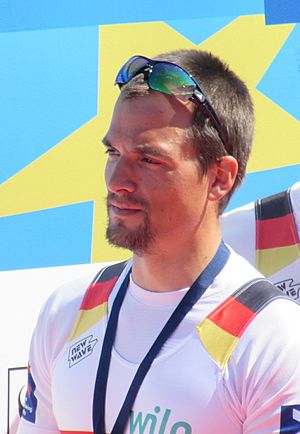
- Uli Hoeneß (born 1952): A former football player and president of Bayern Munich FC.
- Dieter Hoeneß (born 1953): A former football player and manager.
- Maximilian Reinelt (1988–2019): A German rower who won gold and silver medals at the Olympics.
People Connected to Ulm
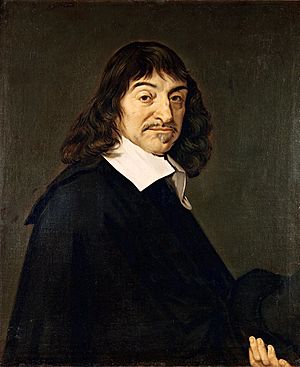
- Johannes Kepler (1571–1630): A German mathematician and astronomer who lived in Ulm.
- René Descartes (1596–1650): A famous philosopher who had an important vision near Ulm in 1619.
- Robert Bosch (1861–1942): An industrialist and inventor who founded Robert Bosch GmbH.
- Herbert von Karajan (1908–1989): A famous conductor who worked in Ulm from 1929 to 1934.
- Hans Scholl (1918–1943) and Sophie Scholl (1921–1943): They founded the White Rose resistance group and spent their youth in Ulm.
Ulm's Global Connections
Ulm is part of the Eurotowns network. While Ulm doesn't have official "twin cities," it has friendly relationships with many places, especially along the Danube River.
 Arad, Romania
Arad, Romania Baja, Hungary
Baja, Hungary Bratislava, Slovakia
Bratislava, Slovakia Budapest, Hungary
Budapest, Hungary Cluj-Napoca, Romania
Cluj-Napoca, Romania Jinotega, Nicaragua
Jinotega, Nicaragua Kladovo, Serbia
Kladovo, Serbia New Ulm, Minnesota, United States
New Ulm, Minnesota, United States Novi Sad, Serbia
Novi Sad, Serbia Sibiu, Romania
Sibiu, Romania Silistra, Bulgaria
Silistra, Bulgaria Subotica, Serbia
Subotica, Serbia Timișoara in Romania
Timișoara in Romania Tulcea, Romania
Tulcea, Romania Vidin, Bulgaria
Vidin, Bulgaria Vukovar, Croatia
Vukovar, Croatia
Images for kids
-
View from Ulm Minster towards Hirschstraße
-
The surrender of Ulm. General Mack and 23,000 Austrian troops surrendered to Napoleon.
-
Saint George's Catholic church, Ulm
-
Ulm: View through Rabengasse towards the minster
-
Sculpture by Niki de Saint Phalle (The poet and his muse) in front of Ulm University
-
Albert Einstein, 1904, age 25
-
Erwin Piscator, ca.1929
-
Hildegard Knef, 1969
-
Maximilian Reinelt, 2016
-
portrait of René Descartes
See also
 In Spanish: Ulm para niños
In Spanish: Ulm para niños


